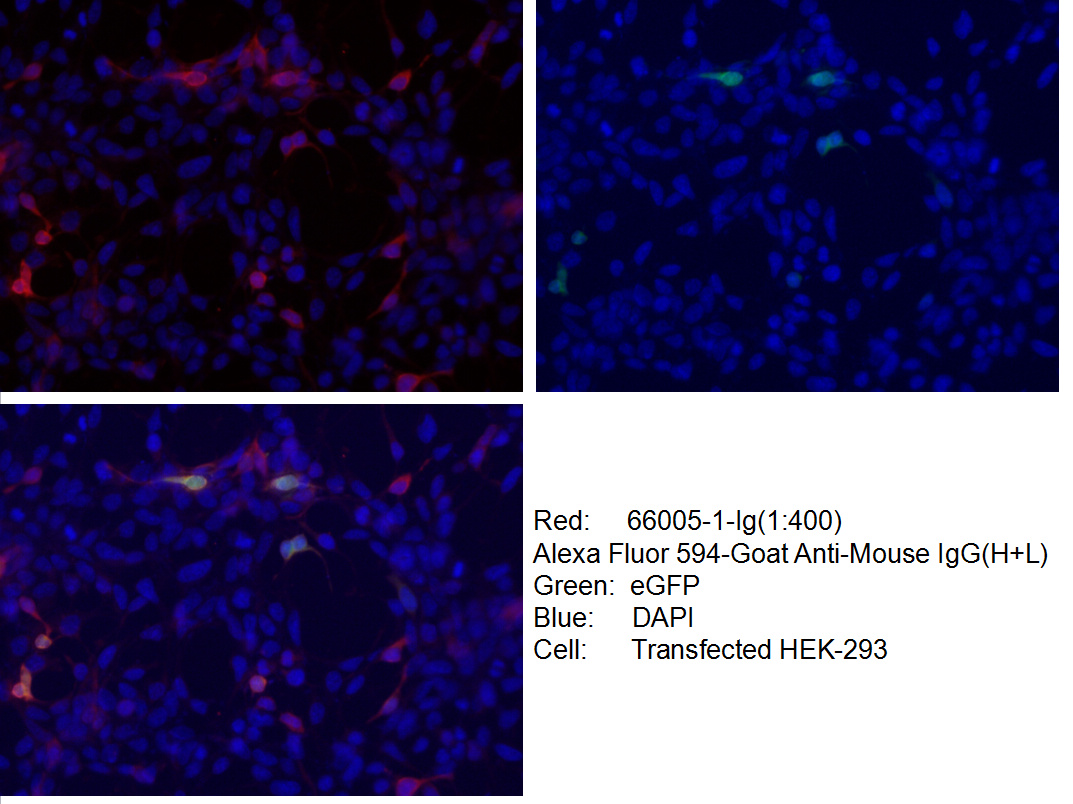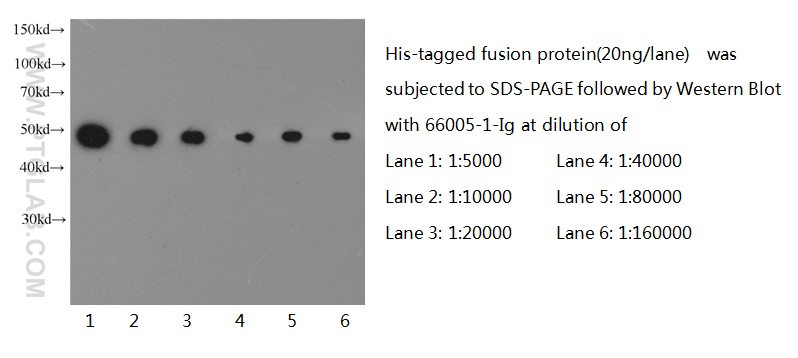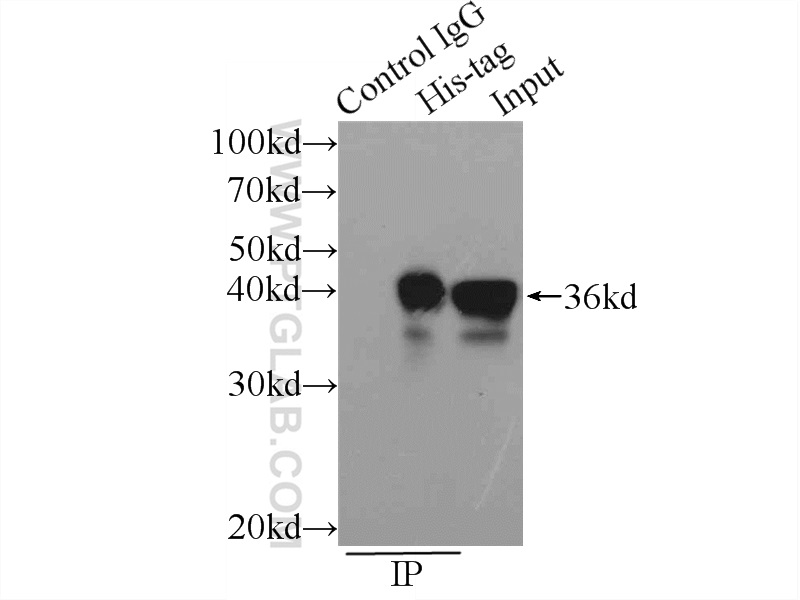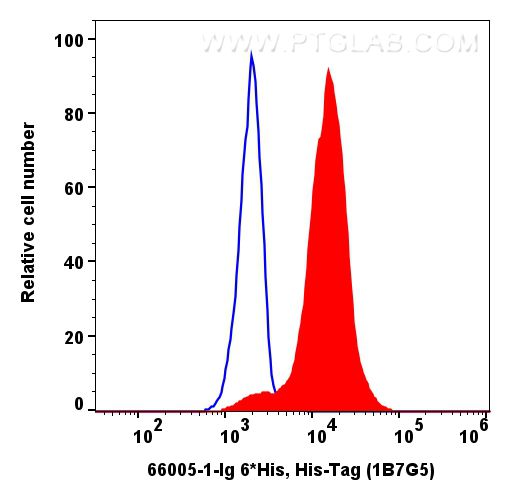验证数据展示
经过测试的应用
| Positive WB detected in | recombinant protein |
| Positive IP detected in | Transfected HEK-293 cells |
| Positive IF/ICC detected in | Transfected HEK-293 cells |
| Positive FC detected in | Transfexted HEK-293 cells |
推荐稀释比
| 应用 | 推荐稀释比 |
|---|---|
| Western Blot (WB) | WB : 1:5000-1:50000 |
| Immunoprecipitation (IP) | IP : 0.5-4.0 ug for 1.0-3.0 mg of total protein lysate |
| Immunofluorescence (IF)/ICC | IF/ICC : 1:200-1:800 |
| Flow Cytometry (FC) | FC : 0.20 ug per 10^6 cells in a 100 µl suspension |
| It is recommended that this reagent should be titrated in each testing system to obtain optimal results. | |
| Sample-dependent, Check data in validation data gallery. | |
产品信息
66005-1-Ig targets 6*His, His-Tag in WB, IHC, IF/ICC, FC, IP, CoIP, ChIP, ELISA applications and shows reactivity with recombinant protein samples.
| 经测试应用 | WB, IF/ICC, FC, IP, ELISA Application Description |
| 文献引用应用 | WB, IHC, IF, FC, IP, CoIP, ChIP, ELISA |
| 经测试反应性 | recombinant protein |
| 文献引用反应性 | human, mouse, rat, chicken, hamster, yeast |
| 免疫原 |
Peptide 种属同源性预测 |
| 宿主/亚型 | Mouse / IgG1 |
| 抗体类别 | Monoclonal |
| 产品类型 | Antibody |
| 全称 | 6*His, His-Tag |
| 别名 | 6*His, His Tag, His Tag, 6*His, 6*his tag, 6*his,His tag |
| 计算分子量 | 0.84 kDa |
| 基因名称 | |
| Gene ID (NCBI) | |
| RRID | AB_11232599 |
| 偶联类型 | Unconjugated |
| 形式 | Liquid |
| 纯化方式 | Protein G purification |
| UNIPROT ID | HISTAG |
| 储存缓冲液 | PBS with 0.02% sodium azide and 50% glycerol, pH 7.3. |
| 储存条件 | Store at -20°C. Stable for one year after shipment. Aliquoting is unnecessary for -20oC storage. |
背景介绍
Protein tags are a protein or peptide sequences located either on the C- or N- terminal of the target protein. His-tag is often used for affinity purification and binding assays. Expressed. The His-tag antibody is a useful tool for monitoring of the His-tagged proteins and recognizes His-tags placed at N-terminal, C-terminal, and internal regions of fusion proteins expressed in bacteria, insect, and mammalian cells. A His-tag (polyhistidine tag) consists of at least six histidine residues that are located at the N- or C-terminus of recombinant proteins. It is commonly used for affinity purification and protein binding experiments.
The recombinant protein has only 6 histidine residues as a tag. Is this sufficient to be detected by your antibody? Is the His-tag antibody able to detect N-terminal and C-terminal His tags?
The His-tag antibody was raised using a 6-His tag peptide as the immunogen, which is ~1 kDa. Some scientists use more than 6 histidine residues as a tag for recombinant proteins to increase affinity to metal ions. A 6-histidine tag is sufficient for specific recognition by the His-tag antibody. It is able to recognize both N-terminal and C-terminal His tags of recombinant proteins produced in various expression systems, including bacteria, yeasts, insect, and mammalian cells.
After purification, I can detect my protein by western blotting using the His-tag antibody but can also see additional bands running lower. What might they represent?
They may represent cleavage products of the recombinant protein. Unspecific protein cleavage can occur during protein production (e.g., in bacteria) or protein purification post the cell lysis steps. Changing expression conditions (temperature, time, induction methods, medium) and using protease inhibitors during purification helps to minimize protein degradation. Additional steps, such as ion exchange, size exclusion, or chromatography, allow isolation of the full-length product.
Can a His-tag antibody be used in applications other than western blotting?
Yes, this antibody has been successfully used for immunofluorescence (IF), immunoprecipitation (IP), and indirect ELISA analysis.
实验方案
| Product Specific Protocols | |
|---|---|
| IF protocol for 6*His, His-Tag antibody 66005-1-Ig | Download protocol |
| IP protocol for 6*His, His-Tag antibody 66005-1-Ig | Download protocol |
| Standard Protocols | |
|---|---|
| Click here to view our Standard Protocols |
发表文章
| Species | Application | Title |
|---|---|---|
Science Structural insight into the SAM-mediated assembly of the mitochondrial TOM core complex. | ||
Nature Fatal swine acute diarrhoea syndrome caused by an HKU2-related coronavirus of bat origin. |






